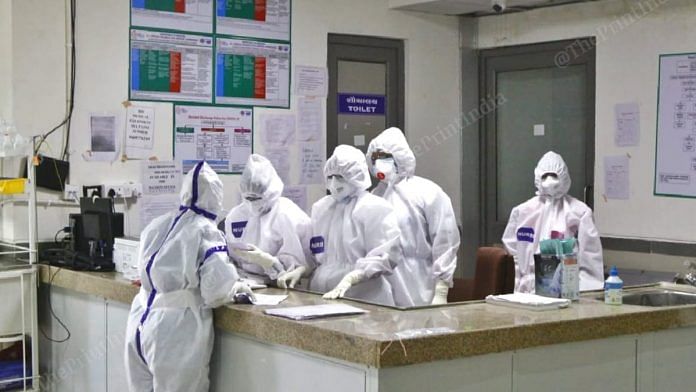New Delhi: Doctors should be allowed to teach in engineering colleges and engineers in medical colleges — this is among the suggestions offered by a team of researchers from the Indian Institutes of Technology (IITs) and other institutes to develop Biomedical Engineering (BME) education in India.
The suggestions have been compiled in a whitepaper titled “Future of Biomedical Engineering programs in India”, an initiative led by Professor M. Manivannan of IIT-Madras and including the participation of academics and researchers from other IITs and research institutes. These include the IITs at Delhi, Roorkee and Bombay, among others, Sree Chitra Tirunal Institute for Medical Sciences & Technology (Thiruvananthapuram), and Kalam Institute of Health Technology (Visakhapatnam).
After making the whitepaper public last week, the researchers are now in the process of submitting the suggestions to the government.
Simply put, biomedical engineering or medical engineering is the application of engineering principles and design concepts to medicine and biology for healthcare purposes. Prosthetic limbs and coronary stents are examples of its application.
“It plays a vital role in a range of clinical fields, from diagnosis and analysis to treatment and recovery, and has entered the public consciousness through the development and proliferation of implantable medical devices, such as pacemakers and artificial hips, as well as the more futuristic technologies such as gene therapy, stem cell engineering and 3-D printing of biological organs,” the paper says about BME.
According to the whitepaper, BME is one of the more recently recognised disciplines in the practice of engineering. It has been described as the fastest-growing job market in the western world, and the paper states that the demand for BME engineers is growing at a rate of about 20 per cent every year.
In the statement released last week, Prof. M. Manivannan, who is a part of the Touch Lab, Biomedical Engineering Group, at IIT-Madras’ Department of Applied Mechanics, said the “main purpose of this current whitepaper is to help improve the quality of BME programs in India by identifying and addressing many challenges, bringing together all the stakeholders of BME in India”.
Also Read: ‘Paper sensor’ developed by IIT Madras could help detect & monitor antimicrobial pollutants
Jaipur Foot, Kalam-Raju stent
The paper dwells on the ways the discipline can be encouraged in India and suggests measures for the government, education institutions, students and people from the industry.
Allowing engineers to teach in medical colleges, and doctors and industrialists in engineering institutes, is one such suggestion. The paper also suggests a revamp in the BME curriculum.
“Apart from the engineering concepts, biomedical engineers need a strong understanding of physiology and cell biology. The focus should be on building the fundamentals of these concepts, not the advanced topics. Advanced topics can be pushed to either the final year or at the Master’s level,” the paper says, adding that a committee should be set up for the development of the curriculum for undergraduate BME.
The paper also proposes incentives for BME teachers to work in medical colleges and participate in their research, apart from memoranda of understanding (MoUs) between hospitals, medical colleges, and engineering institutes, and working closely with doctors, real-world clinical problems and encouraging collaboration between hospitals and educational institutes, as exists between AIIMS and IIT-Delhi.
Industrialists, it adds, should be encouraged to teach courses or participate in research.
It talks about the newly introduced Graduate Aptitude Test in Engineering (GATE) in BME, and how the scores can be used by PSUs to employ graduates who have studied the discipline. BME was introduced as a separate discipline in GATE from 2020.
“Most PSUs in India use GATE scores for employment. With the new GATE (BM) paper, BME students can be competitors to other branch students for PSU jobs. Most PSUs will require BME candidates in the future, and the field BME is emerging; for example, ISRO aims for human-crewed missions that require BME,” the paper adds.
Another suggestion is designing a “medical device corridor” on the lines of the “defence corridor” to give the indigenous industry a push.
“Just as automobile industries have made significant progress in India, device developments can be a mission mode. A medical device corridor can be designed to achieve self-reliance in medical devices. Similar to the automobile consortium, a medical device consortium can be promoted,” the paper adds.
The paper then lists some examples of indigenously developed biomedical instruments and their impact on the Indian economy, including the Jaipur Foot, a low-cost prosthetic limb developed at the SMS Medical College Hospital, Jaipur, in 1968.
“The impact of the Jaipur Foot was pertinently described in Time magazine (fall 1997 issue) thus: ‘People who live inside the world’s many war zones from Afghanistan to Rwanda may never have heard of New York or Paris, but they are likely to know a town in Northern India called Jaipur. Jaipur is famous in strife-torn areas as the birthplace of an extraordinary artificial limb known as the Jaipur Foot that has revolutionised life for millions of landmine amputees.’”
Other examples listed include the Kalam-Raju stent, India’s first indigenous coronary stent devised by former President APJ Abdul Kalam and cardiologist B. Soma Raju, and TTK-Chitra Valve, a mechanical heart valve designed and developed by Sree Chitra Tirunal Institute for Medical Sciences and Technology.
(Edited by Sunanda Ranjan)
Also Read: No life, no hobbies, burnout, lost childhood — the price students pay for a prized IIT seat






